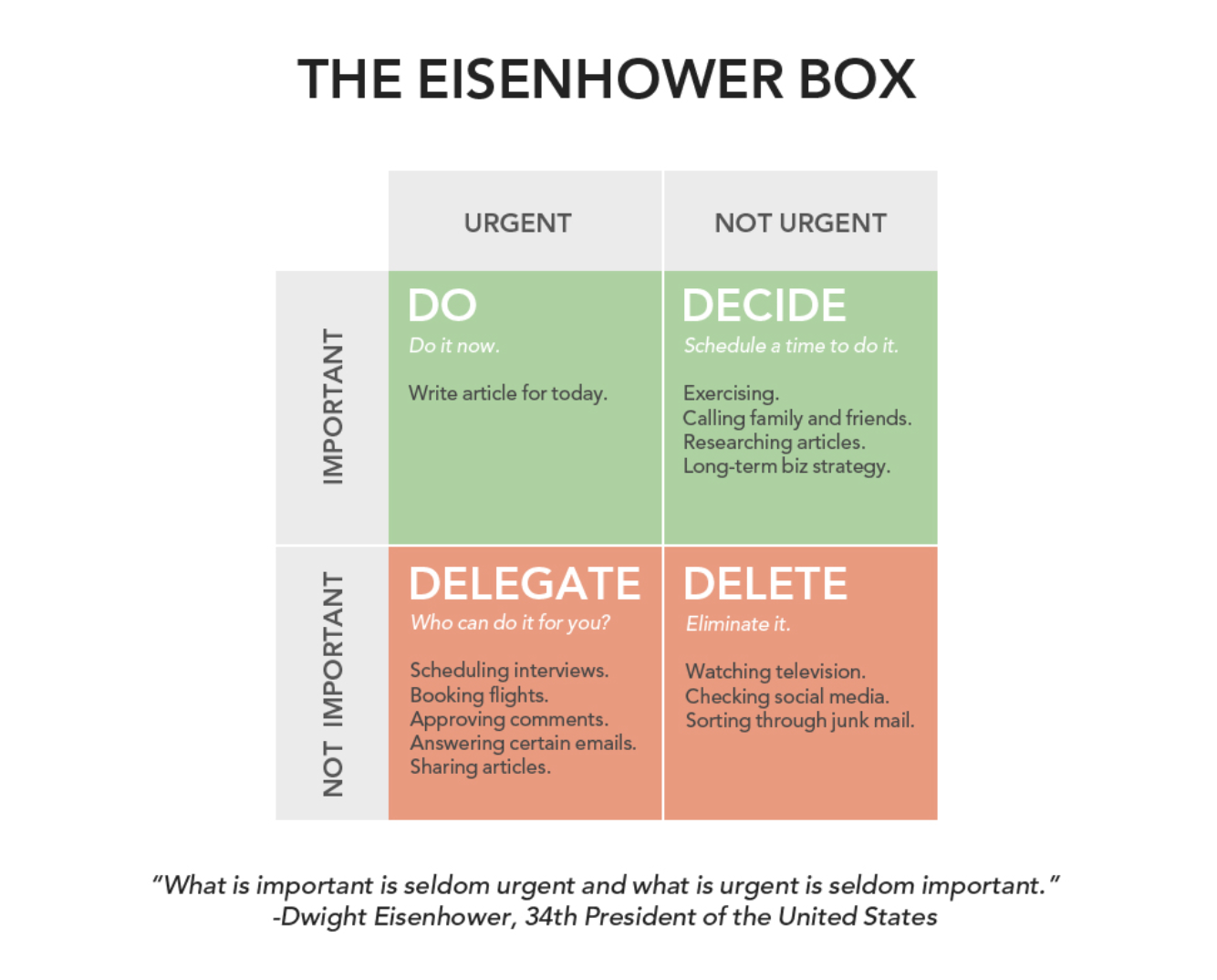
Boost Your Productivity With the Eisenhower Matrix
Eisenhower was a 5-star general during World War II.
Later, he became the 34th President of the United States, helped develop the interstate highway system, established NASA, ended the Korean War, and saw to it that Hawaii and Alaska became U.S. states.
Suffice to say, Eisenhower accomplished a lot during his lifetime.
The question is, how did he become so productive? Did he work harder than everyone else? Did he sleep less? Was he just better at life? The answer to all of those questions is no.
The secret to Dwight D. Eisenhower’s incredible success was his decision-making framework, which is now known as the Eisenhower Matrix.
Keep reading to learn:
-
What is the Eisenhower Matrix?
-
The Difference Between Urgent and Important Tasks
-
The 4 Quadrants of the Eisenhower Matrix
-
How to Boost Productivity With the Eisenhower Matrix
What is the Eisenhower Matrix?

Dwight D. Eisenhower’s ideas were used to create the Eisenhower Matrix.
The Eisenhower Matrix, also known as the Urgent-Important Matrix and the Eisenhower Box, is a framework you can use to organize tasks and boost your productivity.
The framework is based on a speech that Dwight D. Eisenhower gave in 1954. In it, Eisenhower said, “I have two kinds of problems, the urgent and the important. The urgent are not important, and the important are never urgent.”
Three decades later, Stephen Covey, best-selling author of The 7 Habits of Highly Effective People, developed Eisenhower’s insights into the simple decision-making tool we discuss in this article. With it, you can better prioritize tasks by segmenting them into one of four categories:
-
Urgent and important tasks: The tasks you’ll do immediately.
-
Important, but not urgent tasks: The tasks you’ll schedule for later.
-
Urgent, but not important tasks: The tasks you’ll delegate to someone else.
-
Neither urgent nor important tasks: The tasks you’ll delete from your to-do list.
Obviously, to use the Eisenhower Matrix, you have to understand the difference between urgent and important tasks. Let’s talk about that…
The Difference Between Urgent and Important Tasks
To use the Eisenhower Matrix effectively, you have to understand the difference between urgent and important tasks. Fortunately, this distinction is fairly simple:
Urgent tasks require your immediate attention. Why? Because something bad will happen if you don’t complete these tasks as soon as possible. The longer you procrastinate on these things, the more stressed out you’ll become. It’s better to just complete them now.
Examples of urgent tasks include:
-
Finishing a project with a looming due date
-
Covering for a colleague who is out sick
-
Responding to client calls and emails
-
Fixing a leaky pipe in your home
Important tasks do not require your immediate attention. That said, these tasks are critical to the success of your long-term goals. As such, they should be scheduled in advance to make sure that you actually have time and energy to complete them.
Examples of important tasks include:
-
Planning for an important future project
-
Networking with other influential people
-
Learning a new skill to help achieve your goals
-
Completing regular chores around the house
Now that you know the difference between urgent and important tasks, you can segment the items on your to-do list. This leads us to the four quadrants of the Eisenhower Matrix…
The 4 Quadrants of the Eisenhower Matrix

Source: James Clear
The Eisenhower Matrix helps users segment tasks into one of four quadrants.
As mentioned above, The Eisenhower Matrix will help you divide the tasks on your to-do list into one of four categories: urgent and important; important, but not urgent; urgent, but not important; and neither urgent nor important.
Let’s take a closer look at each of these four quadrants:
Quadrant 1: Urgent and Important
Urgent and important tasks have looming deadlines and consequences should you fail to meet them. As such, tasks in this category should be moved to the top of your to-do list.
Just be careful. Spending too much time in Quadrant 1 will limit the amount of time you spend in Quadrant 2 — the ideal place to be. It will also leave you feeling frazzled and stressed, which might lead to burnout.
Typical Quadrant 1 Tasks Include:
-
Writing a blog post for your company’s website
-
Solving an urgent problem for one of your top clients
-
Taking your child to the ER when they break their arm
Quadrant 2: Important, but Not Urgent
Important, but not urgent tasks are directly related to your long-term goals. Because of this, you must make time to complete them. You just don’t have to make time right now.
The tasks in Quadrant 2 don’t have looming deadlines. Instead of tackling them now, schedule them for a later date. (But never reschedule them, if you can help it.)
To increase your productivity levels, try to spend as much time as you can in Quadrant 2. This will enable you to accomplish your biggest goals without getting overwhelmed. It will also help you enjoy your work more because you won’t be rushing from one task to the next.
Typical Quadrant 2 Tasks Include:
-
Meeting like-minded professionals
-
Long-term business planning
-
Changing the oil in your car
-
Exercising at the gym
Quadrant 3: Urgent, but Not Important
Urgent, but not important tasks must be handled in a timely manner. They don’t contribute to long-term goals, though, which is why they should be delegated to others.
Assess your to-do list. Which items need to be done, but don’t require your specific attention and skill set? Assign busy work to personal assistants and lower-level employees. Your valuable time shouldn’t be wasted in Quadrant 3 if you can help it.
Typical Quadrant 3 Tasks Include:
-
Immediately responding to every email in your inbox
-
Approving comments on your company’s blog
-
Booking flights and/or hotel rooms
Quadrant 4: Neither Urgent Nor Important
Admit it: some of the tasks on your to-do list aren’t urgent or important. Tasks that don’t include deadlines or help you achieve long-term goals fall into Quadrant 4.
All Quadrant 4 tasks should be deleted from your to-do list!
Why? They’re a complete waste of time. If you focus your attention on Quadrant 4 tasks, you’ll fall behind in your work. Worse, you’ll never accomplish anything significant in your life.
There’s one exception to this: leisure time.
It’s important to relax, turn your brain off, and enjoy life’s simple pleasures. Eisenhower himself was known for playing bridge and golf on a regular basis. Leisurely pursuits will help you eliminate stress. Just don’t spend too much time on them.
Typical Destructive Quadrant 4 Tasks Include:
-
Watching TV for hours on end
-
Mindlessly scrolling through social media apps
-
Sorting through junk mail, while avoiding other activities
How to Boost Productivity With the Eisenhower Matrix

Ask these 3 questions to use the Eisenhower Matrix more effectively.
The Eisenhower Matrix will help you understand which tasks to focus on and when.
Armed with this information, your productivity levels will skyrocket because you’ll spend more of your time on the things that matter and less on mind-numbing pursuits.
To make sure you get the most out of the Eisenhower Matrix, ask yourself three questions:
1. Which Tasks Can I Eliminate?
Scan through your to-do list and look for Quadrant 4 tasks. Find any? Good, delete them before you do anything else. These tasks won’t help you achieve anything meaningful.
The easiest way to boost your productivity is to reduce the amount of things you need to accomplish every day. Doing so will allow you to focus on the tasks that matter, i.e. the tasks that will help you accomplish your big, important, long-term goals.
2. Which Tasks Will Help Me Accomplish My Goals?
Speaking of goals, what are yours?
You can’t use the Eisenhower Matrix if you don’t know what you’re trying to achieve in your career and life. The entire framework is based on urgent vs. important tasks. Without a firm understanding of one’s goals, there’s no way to identify what’s important and what isn’t.
So take some time to reflect. What do you want to accomplish? When you know the answer to that question, you can segment tasks in an appropriate manner.
3. Which Tools Will Help Me Prioritize Tasks Effectively?
Finally, look for tools to help you organize and schedule tasks. There are plenty of options available to you. Some of our favorites include:
-
Todoist: Todoist is “The world’s #1 task manager and to-do list app.” With it, you can list your professional and personal tasks, label them for easy organization, and put them on a digital calendar so that they actually get done.
-
Trello: Trello is a simple project management app. Use this tool to segment tasks into one of the four Eisenhower Matrix quadrants, set due dates for urgent items on your to-do list, and more. One of our favorite things about Trello is that it’s very visual, which makes it super easy to use for anybody, even if they’re technology averse.
-
Asana: Asana aims to “Make work work for you.” Catchy slogans aside, you can use Asana to organize professional and personal tasks according to the Eisenhower methodology. The best thing about Asana is how flexible it is. The downside is that it can be hard to navigate because it’s equipped with so many features.
You don’t need any of these tools. You can prioritize tasks with a pen and a piece of paper. But why not use technology to your advantage? We encourage you to try one of the three apps above to see if it helps you become more productive.
Wrapping Up
No matter what type of business you are running, the Eisenhower Matrix will help you decide which tasks are most important. You can use it to improve anything you are in from HVAC marketing to Legal Website Design to scaling a startup tech company. That way you can prioritize them, get more done on a regular basis, and accomplish your goals.
If your goals include growing your business, put “Contact Scorpion” into Quadrant 1 or 2 of your Matrix. We’ve helped thousands of small businesses connect with their target audiences and grow revenue. We’d love to help you do the same.
Trending
-
1 SEO Mistakes That Could Be Costing Your Shopify Store Sales
Daniel Hall -
2 Strategies for Safeguarding Assets and Investments
Daniel Hall -
3 The Role of PR Firms in Crisis Management and Damage Control
Nitish Mathur -
4 How to Make Appealing Visuals for Your E-commerce Store
Daniel Hall -
5 The Competitive Landscape of Low-Cost Carriers in Belgium: TUI Fly Belgium’s Position
Daniel Hall





Comments